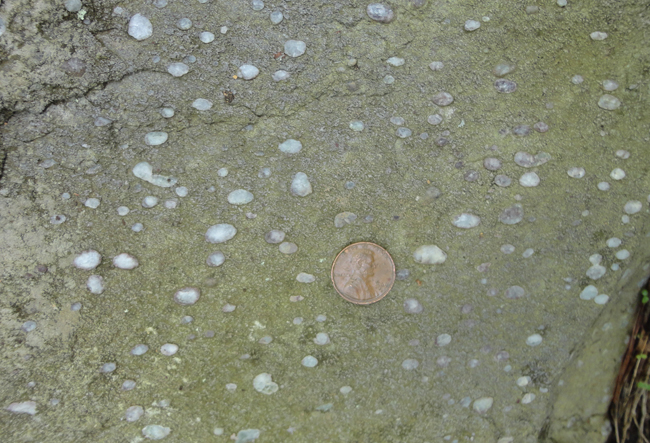5 June 2012
A clutch of amygdules
Posted by Callan Bentley
When I wasn’t looking at creepy-crawlies this past weekend, I was paying attention mainly to the birds (warblers, mainly), but I also couldn’t help but notice the geology. Here is one thing I saw Saturday on the Dark Hollow Falls trail in Shenandoah National Park, Virginia:

Each of these white dots is a section through a more-or-less ellipsoidal mineral deposit called an amygdule (Latin for almond). These amygdules formed as vesicles – volcanic gas bubbles that formed when the rock you see (greenstone of the Catoctin Formation) was erupted as a series of lava flows around 570 million years ago, when the supercontinent Rodinia was breaking up to open the Iapetus Ocean basin. As the basaltic lava degassed, bubbles formed. Some of these bubbles popped, and released their payload of gases to the Neoproterozoic atmosphere, and others didn’t pop. As the lava crystallized, the unpopped bubbles were preserved as a “Swiss cheese” style texture in the volcanic rock.

Later, perhaps diagenetically, or perhaps during the Alleghanian phase of Appalachian mountain building (around 300 to 250 million years ago), these rocks were metamorphosed in a very wet setting. This produced oodles of the Granny-Smith-apple-green mineral epidote, and precipitated mineral deposits in the empty hollows of the vesicles. Common minerals to find filling vesicles (and thus forming amygdules) are milky quartz, jasper, zeolites, and epidote. There are also portions of the Catoctin that have chlorite-bearing amygdules.

The Dark Hollow Falls Trail, just north of Big Meadows in the park, has some of the very best (and BIGGEST) amygdules I have ever seen. Some look for all the world like petrified almonds. Others range upwards to plum-sized. The particular array showcased here caught my eye because of its clean exposure and the uniformity of the mineral filling.


 Callan Bentley is Associate Professor of Geology at Piedmont Virginia Community College in Charlottesville, Virginia. He is a Fellow of the Geological Society of America. For his work on this blog, the National Association of Geoscience Teachers recognized him with the James Shea Award. He has also won the Outstanding Faculty Award from the State Council on Higher Education in Virginia, and the Biggs Award for Excellence in Geoscience Teaching from the Geoscience Education Division of the Geological Society of America. In previous years, Callan served as a contributing editor at EARTH magazine, President of the Geological Society of Washington and President the Geo2YC division of NAGT.
Callan Bentley is Associate Professor of Geology at Piedmont Virginia Community College in Charlottesville, Virginia. He is a Fellow of the Geological Society of America. For his work on this blog, the National Association of Geoscience Teachers recognized him with the James Shea Award. He has also won the Outstanding Faculty Award from the State Council on Higher Education in Virginia, and the Biggs Award for Excellence in Geoscience Teaching from the Geoscience Education Division of the Geological Society of America. In previous years, Callan served as a contributing editor at EARTH magazine, President of the Geological Society of Washington and President the Geo2YC division of NAGT.
I would love to see/take students to see many of the places you’ve stopped to take photos. Would you consider including lat/long for some locations in the blog?
Hi Jen,
I’m happy to share these locations. What do you want to see? I can put together a list of lat/long, or I can put together a customized Google Map for you. Shoot me an email with your specific interests, and I’ll take it from there.
Callan